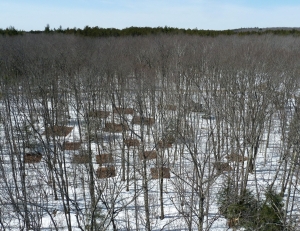You are here
Soil Warming Experiments
 Models of climate change predict a global mean temperature increase of 2-5°C during the next century. Our research is exploring the mechanisms underlying feedbacks from forest ecosystems to the climate system as the result of more than two decades of in situ soil warming. Ongoing field warming studies at the Harvard Forest have experienced 5°C above ambient soil temperatures at three replicated sites since 1991 (Prospect Hill), 2002 (Barre Woods), and 2006 (Soil Warming × Nitrogen Addition Study).
Models of climate change predict a global mean temperature increase of 2-5°C during the next century. Our research is exploring the mechanisms underlying feedbacks from forest ecosystems to the climate system as the result of more than two decades of in situ soil warming. Ongoing field warming studies at the Harvard Forest have experienced 5°C above ambient soil temperatures at three replicated sites since 1991 (Prospect Hill), 2002 (Barre Woods), and 2006 (Soil Warming × Nitrogen Addition Study).
This chronosequence offers a unique opportunity to understand how increasing soil temperatures affect soil biogeochemistry, plant-soil interactions, and microbial community composition and activity over time.
Our soil warming research has three major components:
- continuation of core measurements of carbon and nitrogen stocks and fluxes to track their responses to long-term soil warming to quantify forest ecosystem feedbacks to the climate system;
- short-term temperature manipulations of the plots combined with measurements of key indicators of biogeochemical and microbial-community changes to extend mechanistic understanding of these warming-induced feedbacks; and
- targeted process-level measurements that enhance mechanistic understanding of observed changes in carbon and nitrogen dynamics in response to long-term soil warming.
These projects are supported by the Harvard Forest Long-Term Ecological Research Program and the National Science Foundation Long-term Research in Environmental Biology (LTREB) program.
- Explore data and publications from our soil warming projects.
- See 20-year results and new 26-year results from our longest-running soil warming project.
- Browse HF research projects and multimedia related to soil nitrogen and carbon and soil microbial ecology.

